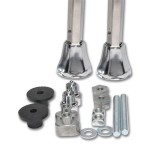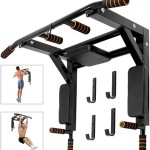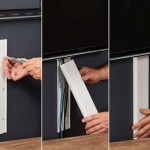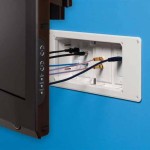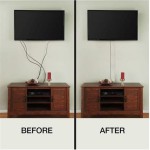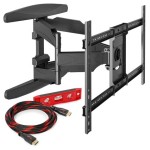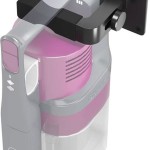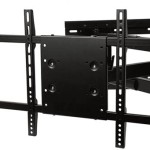TV Hooks for Wall Mounting: A Comprehensive Guide
The advent of flat-screen televisions has revolutionized home entertainment, offering sleek designs and immersive viewing experiences. Central to maximizing the aesthetic and spatial benefits of these TVs is mounting them on a wall. This process not only saves floor space but also provides optimal viewing angles and a cleaner, more modern look. A critical component of any wall-mounted television setup is the TV hook or mounting bracket. Selecting the correct TV hook is paramount to ensuring the safety and stability of the television, as well as the overall success of the installation.
This article aims to provide a comprehensive guide to understanding TV hooks for wall mounting. It will explore various types of TV hooks, delve into the factors influencing the selection process, and offer practical advice on installation and safety considerations. By understanding these aspects, individuals can make informed decisions and successfully mount their televisions with confidence.
Understanding VESA Compatibility
The Video Electronics Standards Association (VESA) establishes standards for mounting interfaces on flat panel displays, monitors, and televisions. VESA compatibility is a critical factor to consider when selecting a TV hook. The VESA Mounting Interface Standard (MIS) defines the hole pattern on the back of the television, specified in millimeters (mm), that the mounting bracket must align with.
The VESA pattern typically appears as two numbers separated by an "x," such as 200x200 or 400x400. The first number indicates the horizontal distance between the mounting holes, and the second number represents the vertical distance. To determine the VESA pattern of a television, refer to the television's user manual or measure the distance between the mounting holes on the back of the set. Most TV manufacturers provide this information readily in the product specifications.
It is crucial to select a TV hook that supports the television's VESA pattern. Using a bracket that is not VESA compatible can lead to installation challenges, instability, and potential damage to the television or the wall. Many TV hooks are designed to accommodate a range of VESA patterns, offering versatility and adaptability to different television models. When browsing for TV hooks, confirm that the bracket explicitly lists the supported VESA patterns and that the television's pattern is included.
Adapters are available to convert VESA patterns if the ideal mount isn't directly compatible. These adapters typically involve attaching plates to the back of the television that provide the necessary mounting holes for the selected bracket. While adapters offer a solution, it is generally preferable to select a TV hook that is directly compatible with the television's VESA pattern to ensure a secure and reliable mounting solution.
Exploring Different Types of TV Hooks
The market offers a diverse range of TV hooks, each designed with specific features and functionalities to cater to different installation requirements and viewing preferences. Understanding the different types of TV hooks is essential for choosing the most suitable option for a particular setup. The primary categories include fixed mounts, tilting mounts, full-motion mounts, and ceiling mounts.
Fixed Mounts: Fixed mounts, also known as flat mounts, are the simplest and most economical type of TV hook. They position the television very close to the wall, typically within an inch or two. Fixed mounts offer a clean and minimalist aesthetic, ideal for situations where the viewing angle does not require adjustment. They are relatively easy to install and provide a secure and stable mounting solution. However, fixed mounts offer no flexibility in terms of tilting or swiveling the television. They are best suited for situations where the television is viewed directly from a single, consistent viewing point.
Tilting Mounts: Tilting mounts allow the television to be tilted vertically, typically forward or downward, to improve the viewing angle and reduce glare. Tilting mounts are particularly useful when the television is mounted higher on the wall, as tilting the screen downward can provide a more comfortable viewing experience. The tilt range is typically limited, usually between 5 and 15 degrees. These mounts are more complex than fixed mounts but still relatively easy to install. They offer a balance between affordability and adjustability.
Full-Motion Mounts: Full-motion mounts, also known as articulating mounts, provide the greatest flexibility in terms of viewing angle adjustment. These mounts feature arms that extend from the wall, allowing the television to be swiveled, tilted, and even extended away from the wall. Full-motion mounts are ideal for situations where the television needs to be viewed from multiple locations within a room or where access to the rear of the television for cable management is required. They are the most expensive and complex type of TV hook to install, but they offer unparalleled versatility.
Ceiling Mounts: Ceiling mounts are designed for situations where wall mounting is not feasible or desirable, such as in commercial settings or rooms with limited wall space. These mounts suspend the television from the ceiling, providing a unique and customizable viewing solution. Ceiling mounts often offer full-motion capabilities, allowing the television to be swiveled and tilted to achieve the desired viewing angle. They require careful planning and installation to ensure stability and safety.
Factors Influencing the Selection of a TV Hook
Choosing the right TV hook involves considering several factors beyond VESA compatibility. These factors include the size and weight of the television, the wall type, desired viewing angle, aesthetic preferences, and budget. A thorough assessment of these factors will help ensure that the selected TV hook meets the specific needs and requirements of the installation.
Television Size and Weight: The size and weight of the television are critical factors in determining the appropriate TV hook. Each TV hook has a specified weight capacity, and it is crucial to select a bracket that can safely support the television's weight. Exceeding the weight capacity of the bracket can lead to instability, damage to the television, or even a complete failure of the mounting system. The television's weight is typically listed in the product specifications. It is advisable to choose a TV hook that has a weight capacity slightly higher than the television's weight to provide an added margin of safety. The size of the TV, measured diagonally in inches, will also influence the choice of mount, particularly with full-motion mounts where arm extensions need to accommodate the TV's width.
Wall Type: The type of wall on which the television will be mounted is another important consideration. Most TV hooks are designed for mounting on drywall with wooden studs. However, other wall types, such as concrete, brick, or metal studs, require specialized mounting hardware and techniques. Drywall alone cannot adequately support the weight of a television. It is essential to locate the wooden studs behind the drywall and secure the TV hook to these studs for a stable and secure installation. A stud finder can be used to locate the studs accurately. For concrete or brick walls, masonry anchors are required. For metal studs, specialized metal stud fasteners are necessary. Consult with a professional if unsure about the wall type or the appropriate mounting hardware.
Desired Viewing Angle: The desired viewing angle will influence the choice between fixed, tilting, and full-motion mounts. If the television will be viewed from a single, consistent location, a fixed mount may suffice. If the television will be mounted higher on the wall or if glare reduction is desired, a tilting mount may be more appropriate. If the television needs to be viewed from multiple locations within a room or if access to the rear of the television for cable management is required, a full-motion mount is the best option.
Aesthetic Preferences: The aesthetic appearance of the TV hook can also be a factor in the selection process. Fixed mounts offer the most minimalist look, as they position the television very close to the wall. Tilting and full-motion mounts are more visible, but some models are designed with sleek and modern aesthetics. Consider how the TV hook will complement the overall décor of the room. Some individuals prefer to conceal the mounting hardware as much as possible, while others prioritize functionality over aesthetics.
Budget: The cost of TV hooks can vary significantly, depending on the type, features, and brand. Fixed mounts are typically the most affordable, while full-motion mounts are the most expensive. Determine a budget and explore the options available within that price range. It is important to balance cost with quality and functionality. Investing in a high-quality TV hook is crucial for ensuring the safety and stability of the television.
By carefully considering these factors, individuals can select a TV hook that meets their specific needs and provides a secure and enjoyable viewing experience.

34 50 Inch Best Twin Hook Tiltable Tv Wall Mount Lp6911b Lcd And Monitor Bracket Made In China Com

The 4 Best Tv Wall Mounts Of 2025 Reviews By Wirecutter

Bulk China Whole 22 Inch 37 Double Hooks Tilting Tv Wall Brackets Tiltable Mount For Plasma Lcd Led Av From Norxon Trading Co Ltd Globalsources Com

The 4 Best Tv Wall Mounts Of 2025 Reviews By Wirecutter

Nbd2 F Fix Wall Tv Bracket 32 47

The 4 Best Tv Wall Mounts Of 2025 Reviews By Wirecutter

B Tech Bt8422 Extra Large Fixed Tv Wall Mount Universal

Titan Tv Wall Mount Bracket Tilting 23 42 30kg Sgb230 Mounts Brackets Horme Singapore

Heavy Duty Ultra Low Profile Tv Wall Mount With Locking Feature Mi 305b It

Television Bracket 26 75 Inch Screens Tiltable Width Adjustable Tv Wall Mount On

